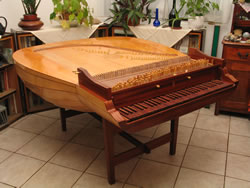

The lautenwerck (also spelled lautenwerk), alternatively called lute-harpsichord (lute-clavier) or keyboard lute, is a European keyboard instrument of the Baroque period. It is similar to a harpsichord, but with gut (sometimes nylon) rather than metal strings (except for the 4-foot register on some instruments), producing a mellow tone.
Contents
The instrument was favored by J. S. Bach, who owned two of the instruments at the time of his death, but no specimens from the eighteenth century have survived to the present day. [1] It has been revived since the twentieth century by harpsichord makers Willard Martin, Keith Hill, and Steven Sorli. Three of its most prominent performers are the early music specialists Gergely Sárközy, Wolfgang Rübsam, and Robert Hill.
